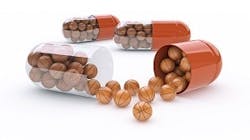As I was thoughtfully filling out my bracket for this year’s March Madness pool during non-work hours, of course (March Madness activities apparently cost employers close to $4B in lost productivity, fyi), Internet-induced attention deficit disorder got the best of me and I started reading about the history of basketball.
Basketball was invented by athletic instructor Dr. James Naismith in 1891, who was tasked with devising a game that students could play indoor during winter months, in a small amount of space. The first basketball game used a soccer ball and two peach baskets as equipment. Naismith created 13 rules, and oddly enough, a large number of those original rules still apply in modern day basketball.
So, as it turns out, the basic infrastructure of the original rule set created 125 years ago is still pretty much intact today. What else do you know with that kind of staying power?
While historians have found evidence of “pills” since BC, the invention that paved the way for the mass manufacture of medicines in the form that most patients know them today came centuries later.
The Scientific Revolution, which continued into the late 1700s, brought sweeping developments in mathematics, physics, biology and chemistry. The end of this period crossed over with the beginning of the Industrial Revolution — which brought us machines and the advent of modern manufacturing practices — creating a perfect, stage-setting collision of science and manufacturing.
The lines started blurring between the chemical industry, textile industry and apothecaries (Bayer, for example, started as an innovative dyestuffs factory in Germany) — which, at the time, made sense from a research angle, but in present day seems somewhat frightening. But what emerged from this was what most claim to be the start of the pharmaceutical industry as we know it today.
The real game-changer came in 1843, when British inventor William Brockedon patented an invention that compressed sodium carbonate and potassium carbonate in a tube, to form solid tablets. Eliminating the need for moisture to bind ingredients in the pill-making process, Brockedon’s invention enabled the mass production of “compressed pills.” This basic oral solid dose manufacturing methodology is quite similar to the OSD manufacturing used today.
Oral solid dosage remains the form of choice for thousands of drugs and billions of patients. Over the past three years, 37 new tablets and 22 capsules have been approved by the FDA.
As the mature dosage form adapts to a changing landscape that involves higher potency products, generics, and the push to change to continuous manufacturing processes, we see OSD manufacturers fine-tuning their processes and equipment, and truly staying in the game.
Oh, and for the record, I had Villanova to win it all in my pool…how did I do?






